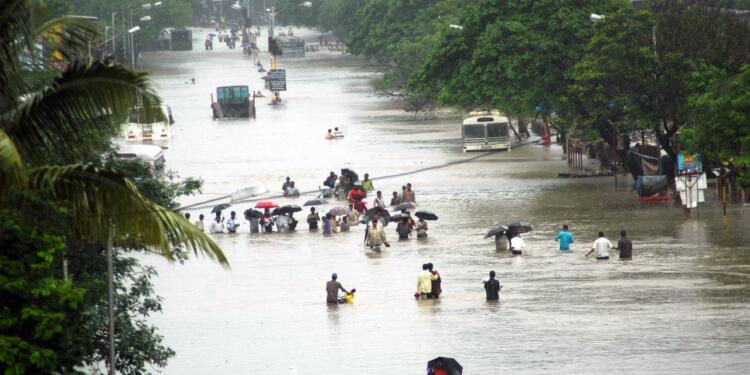On July 26, 2005, Mumbai faced an unprecedented natural disaster that brought the bustling metropolis to a grinding halt. This catastrophic event, now etched in the city’s collective memory as “26/7”, exposed critical weaknesses in urban planning and infrastructure. The floods not only claimed lives and caused extensive damage but also forced Mumbai to reassess its disaster management strategies. Let’s delve into the key aspects of this defining moment in Mumbai’s history.
Record-Breaking Rainfall in Mumbai
Mumbai experienced an extraordinary downpour on that fateful day. The city received a staggering 944 mm of rain within 24 hours, setting a new 100-year record. This deluge ranked as the eighth heaviest rainfall ever recorded globally in a single day. The continuous rain exacerbated the flooding, presenting enormous challenges for Mumbai’s residents and authorities alike.
Mumbai’s Transportation Nightmare
The relentless rainfall paralyzed Mumbai’s transportation systems. The city’s lifeline, its suburban railway network, came to a complete standstill due to severe waterlogging. Consequently, millions of commuters found themselves stranded. Roads turned into rivers, causing unprecedented traffic jams. Low-lying areas like Dharavi and the Bandra-Kurla Complex were submerged, making travel hazardous or impossible.
Extensive Damage to Mumbai’s Vehicles
The floods wreaked havoc on both public and private transport in Mumbai. Thousands of vehicles, including auto-rickshaws, taxis, buses, trucks, and tempos, were damaged or immobilized. This massive destruction led to significant economic losses and logistical challenges for the city.
Mumbai’s Airports Shut Down
For the first time in its history, Mumbai’s airports were forced to close for over 30 hours. The flooding and poor visibility affected operations at Chhatrapati Shivaji International Airport, Sahar, and Juhu aerodromes. Hundreds of flights were cancelled or delayed, adding to the chaos as travelers were left stranded in Mumbai.
Human Toll and Displacement in Mumbai
The floods claimed over 1,000 lives in Mumbai alone, primarily due to drowning, electrocutions, and landslides. Additionally, more than 14,000 homes were destroyed, leaving thousands of Mumbai residents homeless and in urgent need of assistance.
Mumbai’s Communication Breakdown
The deluge significantly disrupted Mumbai’s communication networks. Millions of mobile and landline users experienced outages, making coordination and rescue efforts in Mumbai extremely challenging.
Mumbai’s Infrastructure Failure
Mumbai’s outdated drainage system, a relic from the colonial era, was overwhelmed by the unprecedented rainfall. Furthermore, unchecked urbanization had blocked natural waterways and destroyed mangroves, exacerbating the flooding in Mumbai.
Response to Mumbai’s Crisis
Initially, the government’s response to the disaster was criticized for being slow, leaving many Mumbai residents to fend for themselves. Eventually, the military was mobilized to assist with rescue operations, and relief camps were established across Mumbai to provide essential aid to the affected population.
Mumbai’s Community Spirit
Local citizens and NGOs played a crucial role in rescue and relief operations. Volunteers in Mumbai coordinated effectively, distributing food, water, and other essentials, and offering shelter to those in need.
Lessons Learned and Mumbai’s Future
The 26/7 floods highlighted the urgent need for effective disaster management strategies in Mumbai. In response, the government established disaster management cells and focused on upgrading the city’s drainage systems. The event also raised awareness about sustainable urban planning and the importance of preserving natural habitats in Mumbai.
Economic Impact
The floods had a severe economic impact on Mumbai, India’s financial capital. Many businesses were forced to close temporarily, and the city’s stock exchange remained shut for several days. The total economic loss was estimated to be in billions of rupees, affecting not only Mumbai but also the national economy.
Mumbai’s Resilience and Recovery
Despite the devastation, Mumbai showed remarkable resilience. Within days, the city began to recover, with citizens and authorities working together to clear debris and restore services. This spirit of recovery became a hallmark of Mumbai’s response to the disaster.
Long-term Changes in Mumbai’s Infrastructure
In the years following the 26/7 floods, Mumbai undertook several infrastructure projects to improve its flood resilience. These included widening and deepening of storm water drains, installation of pumping stations, and efforts to protect and restore mangroves along Mumbai’s coastline.
Climate Change and Mumbai’s Future Preparedness
The 2005 floods served as a wake-up call for Mumbai regarding the potential impacts of climate change. Since then, the city has been working on developing more comprehensive climate adaptation strategies, recognizing that extreme weather events may become more frequent in the future.
In conclusion, while Mumbai has made progress in improving its disaster preparedness since 2005, the challenges of urban flooding remain. The 26/7 floods serve as a stark reminder of the vulnerabilities that come with rapid urbanization and inadequate infrastructure in Mumbai. As the city continues to grow and evolve, the lessons learned from this catastrophic event continue to shape Mumbai’s approach to urban planning and disaster management.
ALSO READ: Lessons, India learnt, from the Kargil War!































